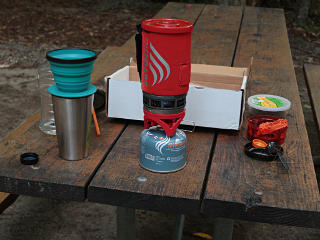
Day two: the big challenge

|
A lovely and downright chilly morning dawned, bringing certain immediate priorities with it. My "coffee in the middle of nowhere" kit had gotten a bit of an upgrade recently, swapping out the clumsy old Melita brass filter in favor of a collapsible silicone X-Brew dripper I'd picked up at REI. This made it so that the entire kit including coffee and sugar containers could fit in the box, which it hadn't before. The filter mesh is very fine, but I found that it needed a fairly brisk pour to keep enough liquid above it for a good extraction. The output was entirely adequate for bootstrapping my day. |
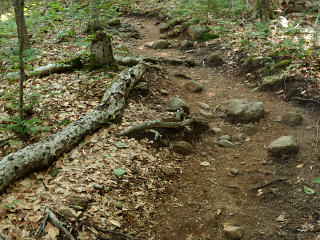
|
The trail was just generic dirt with a few rocks for quite a way, in fact rather foot-friendly so far. I figured that wouldn't last long. |
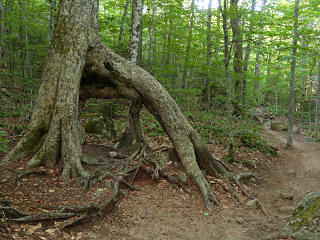
|
More strange root/trunk structures; I wonder if this grew around a rock that had since moved somehow? |
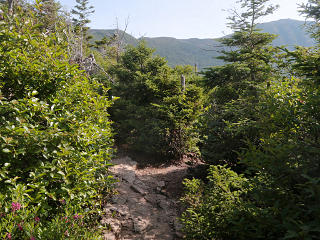
|
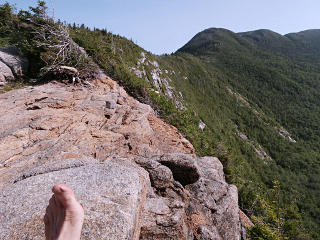
|
| After a while the trees started getting a little scrubbier, and I eventually broke out onto some bare rock slabs along the ridgeline and a better view of what lay ahead. | |
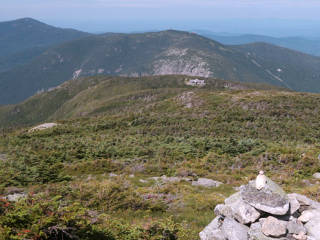
|
I found where the Greenleaf trail continues up from the hut and started
down it -- literally down for a stretch as it dips and goes by the nearby
lake, today through a big glorious mudpuddle.
Then came the last big upward push to Lafayette, and it didn't take long
to rise again to well above the level of the hut and see Cannon dwarfing
it from behind.
It's not too hard to squint a little here and envision the Beacons of Minas Tirith flaring on the peaks as epic music plays in the background ... |
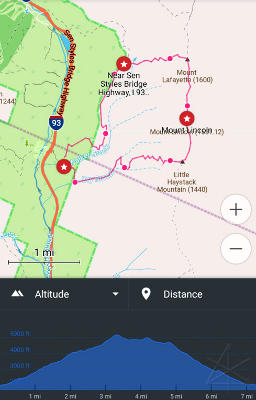
|
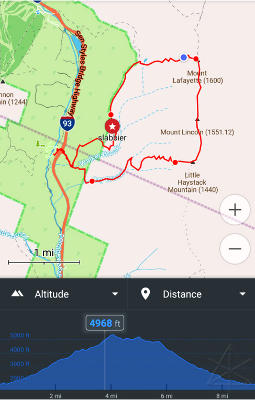
|
|
| Predicted | Actual | |
|
While reliance on "devices" alone is discouraged in the hiking literature,
having Open Streetmap running on the phone serves several purposes at
once.
[It's also pretty hard to get lost on this loop if you've done *any*
advance studying.]
Many recreational trails are accurately documented in its database and
keep being added to and refined, so it's not only a decent map, it's an
interactive display of one's progress and a fairly reliable way to capture
an entire hike's track for later analysis.
In my own process of using it I had added or fixed a few familiar trails
in the global database too, using recorded tracks and on-the-ground local
knowledge.
And I had just discovered one more interesting aspect during my trip prep: even though the map displays in the Android app have no information about topography or height, some concept of elevation data must be embedded because it implicitly appears in the process of route planning. When I laid out a navigation route starting near the bottom of Old Bridle Path and ending near the same point with waypoints over the peaks, the app constructed a route quite accurately along the trails and when I displayed the route details, there was an elevation profile -- seemingly from nowhere! Thus, after doing the hike I could compare the "predicted" data versus the actual elevation figures captured during the day, and they're quite close. The difference is that a completed track has real-life points in it, allowing detailed display of data anywhere along it by sliding a cursor along the track timeline. Still, being able to mess with a fabricated *theoretical* hiking route and get an idea of its height profile is useful. The OsmAnd community offers a "hillshade" plug-in as a for-pay additional app feature, and I suspect that it simply allows representative interpolated display of contour information that already comes in the database downloads. Perhaps having it would make my map look more like this. Meh -- don't really need it after all, I can do that sort of stuff online. Owww ?! So note where my marker is in the "actual" trace above, corresponding to the blue dot just west of Mt. Lafayette. There I was, toiling upward near 5000 feet with the summit in easy sight, and then came the major setback of the trip. I noticed that my right Achilles tendon was hurting a little. I took a brief rest, gave it a quick stretch, and kept slogging. Then it started hurting more, and the area of interest seemed to move up my leg toward the calf. In about ten minutes I realized that I was having a partial recurrence of the pulled calf muscle I suffered back in December, and after a couple of particularly painful steps I knew that I needed to stop putting high load on that leg and foot RIGHT NOW, and baby it as much as I could. My body naturally adopted a sort of limping gait that basically used the right leg as a stump, not using the ankle for any meaningful "launch", like I'd had to do for a couple of weeks in January. [The original injury was noted in that year's Arisia writeup: stated formally, a tear in the medial head of the gastrocnemius near the musculotendinous junction, an absolutely textbook injury often brought on by various athletic activities including hiking.] Well, this suddenly sucked, and raised a serious quandary: Now what? Having my walking ability compromised could mean some bit of trouble. I was at my maximum elevation and nearing the halfway point of the hike, so going either back or forward meant a long gnarly way down. I had no idea why the damn thing suddenly went out on me like that, but it clearly wasn't going to magically fix itself in the next ten minutes. The other immediate ass-kicker was the mystery factor! There hadn't been any *hint* of a problem up Welch-Dickey, or any trip before that -- in fact, I had been hiking fairly vigorously over much of the spring/summer, so it wasn't like I got off the couch and tackled a strenuous 9-miler unprepared. Nothing weird had happened that morning that I could identify -- I didn't stumble or come down funny on that foot as far as I could remember. I was a little fatigued overall but knew the major climb would be over soon, I was drinking plenty of water and taking short rest stops once in a while, I was really trying to pace myself -- not trying to beat any records or the other hikers around me. | ||
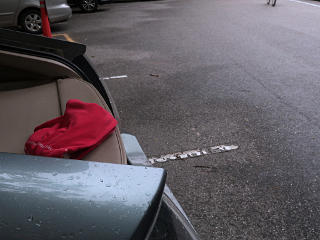
|
I got rather lucky on my timing, in fact, as rain started to come down *just* as I finally gimped my way back to the car. But it started slowly enough that I still had time to clean up a bit in the same piece of stream that I had accessed from the campsite the day before, change to a dry shirt, and relax for a bit before getting on the road home. As I headed through Lincoln, the rain became heavier and I felt bad for the people I had seen heading *up* the trail less than an hour ago. | |
|
So I made it off the mountain without killing or maiming myself or
needing an airlift out, and still enjoyed the overall trip.
9 and change arguably exhilarating miles, total time about 7 hours.
My feet felt like they'd barely noticed the distance -- none of the post-hike
tenderness I get once in a while after especially rough terrain.
My knees also felt just fine, even after one of the longest downhills
I'd done all year -- from experience, those arched-over "side fascia"
stretches really do help with the illiotibial situation despite how
some medical literature dismisses the idea.
Maybe all that and "hey, nobody died!" makes for a successful trip and mostly passing the test I'd set for myself -- elements of win, elements of fail. It still really galled me that I'd now have to stay off the calf for another couple of weeks and heal back up. That was *not* part of the resources I had any intention of "using up", I always need those locomotors! But it was already clear that the pull wasn't nearly as bad as it had been back in December, when I hadn't realized what was happening and kept trying to run on it. It was also likely that going right into Arisia after getting home kept me moving on it more than I should have and didn't allow for rest and the right kind of rehab, so there may have been some remaining scar-tissue in there which never got massaged away properly, left a weak point, and that's the area that let go. This time, I'd take better care of it in the recovery process and hopefully be back on the trail in short order.
| ||